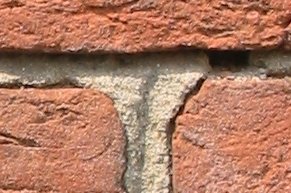Mortar (masonry)
- This article describes the use of the term "mortar" in masonry. For other meanings, see mortar.
Mortar is a material used in masonry to fill the gaps between blocks in construction. The blocks may be stone, brick, breeze blocks (cinder blocks), etc. Mortar is a mixture of sand, a binder such as cement or lime, and water and is applied as a paste which then sets hard.
Gypsum mortar
The earliest known mortar was used by the ancient Egyptians and was made from gypsum. This form was essentially a mixture of plaster and sand and was quite soft.
Portland cement mortar
Portland cement mortar (often known simply as cement mortar) is created by mixing Portland cement with sand and water.
It was invented in the mid nineteenth century, as part of scientific efforts to develop stronger mortars than existed at the time. It was popularised during the nineteenth century and it had superseded lime mortar by 1930 for new construction. The main reason for this was that it sets hard and quickly, allowing a faster pace of construction. However, as a general rule it should not be used for the repair of older buildings constructed in lime mortar, which require the flexibility, softness and breathability of lime if they are to function correctly.
Lime mortar
Lime mortar is created by mixing sand, slaked lime and water.
The earliest known use of lime mortar dates to about 4000 B.C.E. in Ancient Egypt. Lime mortars have been used throughout the world, notably in Roman Empire buildings throughout Europe and Africa. The vast majority of pre-1900 masonry buildings in Europe and Asia are built from lime mortar.
The process of making lime mortar is simple. Limestone is burnt in a kiln to form quicklime. The quicklime is then slaked (mixed with water) to form slaked lime, either in the form of lime putty or of hydrated lime powder. This is then mixed with sand and water to form mortar.
This kind of lime mortar, known as non-hydraulic, sets very slowly through reaction with the carbon dioxide in air. A very thick wall made of lime mortar may take centuries to completely set and harden. This is normal and not problematic.
The speed of set can be increased by using impure limestones in the kiln, to form a hydraulic lime that will set on contact with water. Such a lime must be stored as a dry powder. Alternatively a pozzolanic material such as calcined clay or brick dust may be added to the mortar mix. This will have a similar effect of making the mortar set reasonably quickly by reaction with the water in the mortar.
Using Portland cement mortars in repairs to older buildings originally constructed using lime mortar can be problematic. This is because lime mortar is softer than cement mortar, allowing brickwork a certain degree of flexibility to move to adapt to shifting ground or other changing conditions. Cement mortar is harder and allows less flexibility. The contrast can cause brickwork to crack where the two mortars are present in a single wall.
Pozzolana mortar
Pozzolana is a fine, sandy volcanic ash, originally discovered and dug in Italy at Pozzuoli in the region around Vesuvius, but later at a number of other sites. Vitruvius speaks of four types of pozzolana. It is found in all the volcanic areas of Italy in various colours: black, white, grey and red. Also see pozzolanic ash for more information.
Finely ground and mixed with lime it acts like Portland cement and makes a strong mortar that will also set under water.
Footnotes
Credits
New World Encyclopedia writers and editors rewrote and completed the Wikipedia article in accordance with New World Encyclopedia standards. This article abides by terms of the Creative Commons CC-by-sa 3.0 License (CC-by-sa), which may be used and disseminated with proper attribution. Credit is due under the terms of this license that can reference both the New World Encyclopedia contributors and the selfless volunteer contributors of the Wikimedia Foundation. To cite this article click here for a list of acceptable citing formats.The history of earlier contributions by wikipedians is accessible to researchers here:
The history of this article since it was imported to New World Encyclopedia:
Note: Some restrictions may apply to use of individual images which are separately licensed.
